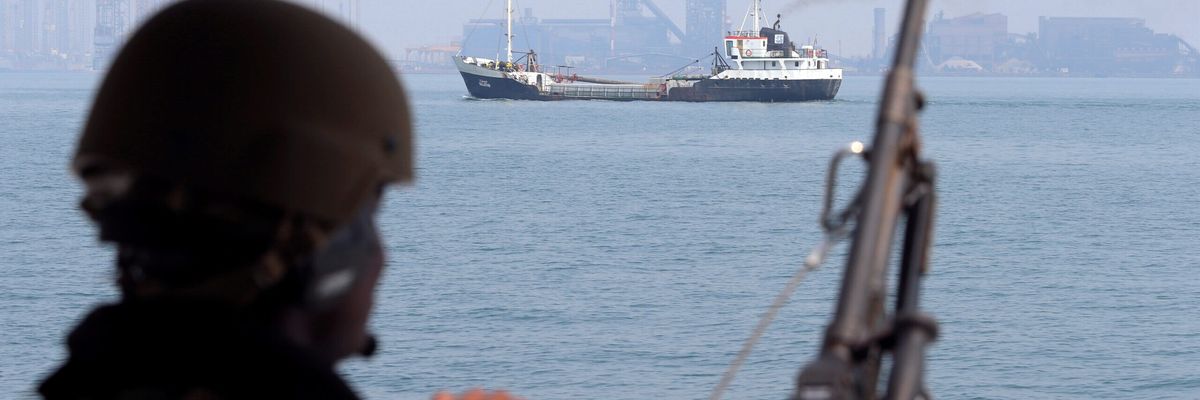The last time the United States placed armament and military personnel, ready to fight, on ocean-going commercial vessels was during the world wars of the 20th Century.
In World War II, the U.S. Navy organized an Armed Guard that served on merchant ships — an unpopular duty, given how the freighters to which the sailors were assigned represented targets for the enemy at least as much as any offensive capability to inflict significant damage in return. Hundreds of these merchant ships were sunk despite their Navy contingent aboard, and some 2,000 members of the Armed Guard died.
The closest the United States has come to any similar arrangement since then was in escorting Kuwaiti oil tankers during the “tanker war” phase of the Iran-Iraq War in the 1980s. This time the United States did not go so far as to place its own military personnel on the commercial vessels, although the tankers were reflagged as a legal nicety to go with the escorting by U.S. Navy warships.
The operation was only a partial success. Although it may have deterred some attacks by surface vessels, Iran still managed to inflict damage through the use of mines. In a humiliating revamping of the convoys, U.S. warships were not out in front providing protection. Instead, they meekly followed the tankers because they were more vulnerable than the much bigger oil carrier to being sunk by mines.
These previous instances occurred in wartime, within much larger conflicts in which combat was already raging. But now, according to U.S. officials speaking anonymously, the Biden administration is considering the placement of armed U.S. military personnel aboard commercial vessels transiting the Strait of Hormuz, which links the Persian Gulf with the Arabian Sea and open ocean. Such an arrangement would go even beyond what the United States did in the 1980s.
The placing of troops on commercial ships is reportedly still only a proposal, but it comes amid actual escalation of the U.S. military presence in an around the Persian Gulf. Recent deployments increasing that presence have included Navy ships, Marines, and fighter aircraft.
These deployments run contrary to a stated intention of multiple U.S. administrations, of both parties, which is to reduce, not increase, U.S. military involvement in the Middle East and to pivot attention and resources elsewhere, especially to the East Asia and Pacific region. The continued — and now, increased — military involvement in the Middle East, notwithstanding that intention, perpetuates U.S. vulnerabilities. The newly deployed personnel may become, like the U.S. troops that are still in Iraq and Syria, targets of hostile fire. Their presence carries the added risk of drawing the United States into even bigger armed conflicts.
The deployments involve stepping into a zone of regional rivalries and is not a simple matter of protecting good guys against bad guys. Despite the perennial fixation on Iran, Tehran’s regional rivals — including ones that are the origin or destination of much of that commercial shipping that the administration wants to protect — are just as distant from American values and interests. Saudi Arabia, traditionally the principal rival, is at least as much of an authoritarian state as Iran and an oppressive violator of human rights whose actions and ideology have had lethal consequences for Americans both individually and on a larger scale.
The stated reason for considering the placement of U.S. troops on commercial ships, and part of the background to the other U.S. military deployments to the region, involves Iran’s interception, seizure, or other harassment of some oil tankers transiting the Strait of Hormuz. With different U.S. policies, this situation could have been avoided. Iran has not intercepted shipping because Iranians have some genetic malice that compels them to do such things. As with many other Iranian policies and actions, this practice is reactive.
It was the United States, not Iran, that began the latest round of going after another nation’s tankers and seizing its oil. The U.S. actions reflect a unilateral U.S. policy of trying to prevent Iranian oil exports. This policy is not grounded in international law, and Iran unsurprisingly has labeled the U.S. seizure and selling of Iranian oil as “piracy.” The U.S. government has not found a buyer for a tanker full of Iranian oil that it seized at sea in April and brought to Houston, because shippers and potential buyers fear repercussions.
This dynamic partly echoes the tanker war of the 1980s. It was the Iraqi regime of Saddam Hussein — who started the overall Iran-Iraq War, and toward whom U.S. policy was then tilting — who initiated attacks against tankers and other commercial oil facilities. Iran responded to those attacks on its own ships and infrastructure by targeting tankers of Iraq’s ally Kuwait.
The timing of some of the recent Iranian intercepts of shipping make the tit-for-tat nature of the Iranian actions obvious. In response to the U.S. seizure of the Iranian tanker in April, Iran just a few days later took control in the Gulf of Oman of a tanker carrying oil from Kuwait and chartered by Chevron.
Other Iranian interception of shipping has not had this immediate tit-for-tat nature but is a more general response to the U.S. economic warfare against Iran, which in effect continues the Trump administration’s “maximum pressure” policy. Iran is sending a message that it cannot be ignored, that if it is not allowed to export its oil, then other oil producers will have difficulty exporting theirs, and that it needs the concentrated attention of the U.S. government in finding a replacement for the agreement that had restricted Iran’s nuclear activities in return for partial sanctions relief and that Trump junked in 2018.
Any consideration of the deployment of U.S. troops on commercial ships needs to address several important questions and risks. Foremost among these is the substantial danger of incidents at sea leading to wider warfare between the United States and Iran. This risk would ensue from any action in which American personnel were involved in exchanges of fire but would be especially high in the event of American casualties. In response to such an incident, strong domestic political pressure would push the administration toward even greater military escalation.
Further questions arise from the fact that the vessels to be protected are commercial operations associated with mostly non-U.S. crews, ship owners, and commodity traders. If the protection is to be afforded only to selected vessels, this would be a kind of industrial policy on steroids that would entail the usual questions surrounding any industrial policy about picking winners and losers.
If the protection is more comprehensive, then American personnel would be literally taken for a ride on many vessels whose mission is defined in terms of the interests of foreign companies and foreign states, which often will differ from the interests of the United States.
When one of these vessels gets into a dicey situation at sea, who exactly is in charge? Americans may be manning the guns, but a commercial captain is presumably still at the helm and still the master of the ship. Such questions matter because the occurrence or avoidance of a violent incident at sea may depend on immediate navigational decisions that would affect whether, say, a potentially hostile craft gets too close for comfort.
With commercial operations that have security risks, such as exporting oil through the Persian Gulf and Strait of Hormuz, the scope of operations usually is defined by insurance rates and the decisions of operators in response to those rates—decisions that take into account wider considerations such as global demand for oil. U.S. intercession in this business would involve partly taking over functions that may be better left to the market and Lloyds of London.
More fundamentally, escalation of the U.S. military presence and military operations in the Persian Gulf region runs directly against a welcome recent trend toward de-escalation of tensions in that region. This trend has included the Chinese-mediated restoration of diplomatic relations between Iran and Saudi Arabia and a warming of relations between Iran and the United Arab Emirates. The smaller Gulf Arab states of Kuwait, Qatar, and Oman have been even more forward than the Saudis and Emiratis in expanding peaceful relations with Iran.
U.S. policymakers need to think carefully about what mark the United States will leave on this region as an outside intervenor. It could be a positive mark, similar to what the Chinese have done, of greater peace and stability—which is in the interests of regional states, global energy supplies, and the United States. It would be unfortunate if the mark instead were one of increased tension and instability, by reversing the “pivot” and putting added military resources, with associated commitments, back into the region.
















